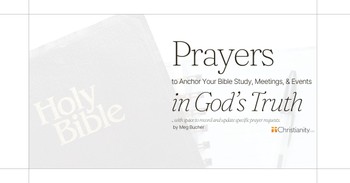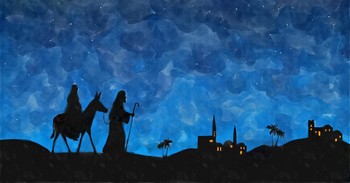We know there were many witnesses to the crucifixion, but how many? What did they say to Jesus, and what did he say back? These articles explore who was at the cross, and what we can learn from their stories today.
Table of Contents
- Who Were the People Present at the Crucifixion?
- What Was Jesus' Message to John and Mary at the Cross?
- Who Were the Two Criminals at the Crucifixion?
Who Were the People Present at the Crucifixion?
G. Campbell Morgan summarizes the major witnesses at Golgotha, from the friends to the executioners.
Women at the Crucifixion
We take it then for granted that four women are mentioned as being present at the crucifixion of the Lord.
In John we see two pairs, the unnamed women, the mother of the Lord and her sister; and the two women who are named, Mary of Clopas, and Mary Magdalene.
- "Near the cross of Jesus stood his mother, his mother’s sister, Mary the wife of Clopas, and Mary Magdalene." (John 19:25)
As Luke records, there were many other women, but these stand prominently out, as having been most closely associated with Him.
- "A large number of people followed him, including women who mourned and wailed for him." (Luke 23:27)
- "But all those who knew him, including the women who had followed him from Galilee, stood at a distance, watching these things." (Luke 23:49)
Roman Soldiers, Two Criminals, and the Roman Centurion
All the evangelists speak of the presence of the soldiers, and of the two malefactors crucified one on either side of Jesus.
Matthew, Mark, and Luke draw special attention to the centurion in charge of the carrying out of the crucifixion, and they give some account of how he was impressed in the presence of the Crucified.
- According to Matthew he said, "Surely he was the Son of God" (Matthew 27:54)
- According to Mark, "Surely this Man was the Son of God" (Mark 15:39)
- According to Luke, "Surely this was a righteous Man" (Luke 23:47)
Let me at once say that there is no contradiction between Matthew and Mark on the one hand, and Luke on the other. It is almost certain that the centurion said both of these things. It is certainly conceivable that as this man watched Jesus on the Cross, he gave utterance to more than one sentence, and we believe therefore that while Matthew and Mark chronicle the statement which impressed them, Luke chronicled what appealed to him, and was in perfect harmony with his whole scheme of teaching. The accounts are rather complementary than contradictory.
Chief Priests and Jewish Leaders
The presence of the chief priests is recorded by Matthew, Mark, and John, Luke making no reference to them. Matthew, Mark, and Luke refer to the scribes, elders, or rulers, comprising the Sanhedrin, while John ignores their presence.
- "In the same way the chief priests, the teachers of the law and the elders mocked him." (Matthew 27:41)
- "In the same way the chief priests and the teachers of the law mocked him among themselves. 'He saved others,' they said, 'but he can’t save himself!'" (Mark 15: 31)
- "The people stood watching, and the rulers even sneered at him. They said, 'He saved others; let him save himself if he is God’s Messiah, the Chosen One.'” (Luke 23:35)
- "The people stood watching, and the rulers even sneered at him. They said, 'He saved others; let him save himself if he is God’s Messiah, the Chosen One.'" (John 19:21)
Multitudes and Disciples
Luke, who wanted to show the universality of the work and relation of Jesus, declares the presence of great multitudes of the people.
- "A large number of people followed him, including women who mourned and wailed for him." (Luke 23:27)
John alone tells us that the disciples were also there, and he only, moreover, refers to the fact of his own presence, and this in order that he may record Christ's committal of His mother to his care.
- "When Jesus saw his mother there, and the disciple whom he loved standing nearby, he said to her, 'Woman,here is your son,' and to the disciple, 'Here is your mother.' From that time on, this disciple took her into his home." (John 19:26-27)
Standing back and gazing out upon that mixed multitude, we notice the women, the soldiers, the malefactors, the centurion, the chief priests, the members of the Sanhedrin, the group of His own disciples, and in addition to these, the vast multitudes of people from the whole surrounding country. All sorts and conditions of people are gathered to the Cross, representative crowds, the whole scene being a picture and a prophecy of how, through all the centuries, every sort and condition would be gathered to the uplifted Cross of the Son of man.
Adapted from The Crises of the Christ, Book V, Chapter XXIV, by G. Campbell Morgan. Previously published on Christianity.com on September 13, 2010.
What Was Jesus' Message to John and Mary at the Cross?
"but standing by the cross of Jesus were his mother and his mother's sister, Mary the wife of Clopas, and Mary Magdalene. When Jesus saw his mother and the disciple whom he loved standing nearby, he said to his mother, "Woman, behold, your son!" then he said to the disciple, "Behold, your mother!" And from that hour the disciple took her to his own home. - John 19:25-27
At the foot of the cross, there were four women who had been followers of Jesus, including his mother Mary (John 19:25). In that moment, Jesus, despite being crucified, noticed John, son of Zebedee, who was known as the disciple he loved and also the author of this Gospel. He said to Mary that John would now be like a son to her, and he told John that Mary would be like his mother (John 19:26-27). Immediately, John took Mary into his home (John 19:27).
Even while suffering on the cross, Jesus made sure to fulfill his duty to care for his widowed mother. He chose John to look after her instead of one of her biological sons because they had not yet believed in him (John 7:5). This event highlights the importance of spiritual relationships over biological and physical ones, as emphasized in passages like Matthew 12:46-50.
Jesus tenderly provides for his mother at His death. It is probable that Joseph, her husband, was long since dead, and that her son Jesus had supported her. Now that He was dying what would become of her? He saw her standing by and knew her cares and griefs, and He saw John standing not far off. So, He established a new relationship between His beloved mother and His beloved disciple. He said to her, "Woman, behold your son, for whom, from now on, you must have a motherly affection," and to John, "Behold you mother, to whom you must pay a sonly duty." And so from that hour, that hour never to be forgotten, that disciple took her to his own home.
Notice the care Christ took of His dear mother. He was not so much taken up with a sense of His sufferings as to forget His friends, all whose concerns He bore. His mother, perhaps, was so taken up with his sufferings that she didn't think of what would become of her, but He did. He had no other way to provide for His mother than by His interest in a friend, which he does here.
This was an honor put upon John, and a testimony both to his prudence and to his fidelity. If He who knows all things had not known that John loved Him, He would not have made him Mary’s guardian. It is a great honor to be employed for Christ and to be entrusted with any of His interest in the world.
It was also a great responsibility for John, but he cheerfully accepted it and took her to his own home, not objecting the trouble nor expense, nor his obligations to his own family, nor the ill-will he might contract by it. According to Nicephoras’s Ecclesiastical History (book 2, chapter 3), Mary lived with John at Jerusalem eleven years and then died. Others, however, say she went with him to Ephesus.
Why Did Jesus Use "Woman" and Not "Mother"?
Jesus calls Mary woman, not mother, not out of any disrespect to her, but because mother would have been a cutting word to her who was already wounded with grief. He directs her to look upon John as her son: "Behold him as thy son, who stands there by you, and be as a mother to him."
Within the language at that time, it was not disrespectful for Jesus to have referred to Mary as "woman" when he said, "Woman, behold your son" (John 19:26). In the context of the Bible and the culture of that time, addressing someone as "woman" was not necessarily disrespectful. It was a common way of addressing women, even by Jesus himself on other occasions.
In this specific situation, while hanging on the cross, Jesus was entrusting the care of his mother, Mary, to the disciple whom he loved, traditionally identified as John. He was essentially making sure that Mary would be taken care of after his death, as it was a gesture of love and concern for her well-being. The use of "woman" in this context can be seen as a way of emphasizing the importance of this new relationship between Mary and John, rather than as a sign of disrespect. It was a solemn and compassionate moment during a difficult time.
Adapted from Matthew Henry's Commentary on the Whole Bible John 19). Previously published on Christianity.com as "What Did Jesus Mean By "Woman, Behold Your Son'?" on August 3, 2010.
Who Were the Two Criminals at the Crucifixion?
It was no accident that Jesus was crucified between two thieves. There are no accidents in a world that is governed by God. Much less could there have been any accident on that day, or in connection with that event of all events - a day and an event which lie at the very center of the world’s history. No, God was presiding over that scene. From all eternity He had decreed when and where and how and with whom his Son should die. Nothing was left to chance or the impulsiveness of man. All that God had decreed came to pass exactly as He had ordained, and nothing happened save as He had eternally purposed. Whatsoever man did was simply that which God’s hand and counsel "determined to be done" (Acts 4:28).
When Pilate gave orders that the Lord Jesus should be crucified between the two criminals, all unknown to himself, he was simply putting into execution the eternal decree of God and fulfilling His prophetic word. Seven hundred years before this Roman officer gave his command, God had declared through Isaiah that His Son should be "numbered with the transgressors" (Isaiah 53:12). How utterly unlikely this appeared, that the Holy One of God should be numbered with the unholy; that the very one whose finger had inscribed on the tables of stone the Law should be assigned a place with the lawless; that the Son of God should be executed with criminals - this seemed utterly inconceivable. Yet, it actually came to pass. Not a single word of God can fall to the ground. "Forever, O Lord, your word is settled in heaven" (Psalm 119:89). Just as God had ordained, and just as He had announced, so it came to pass.
Why did God order it that His beloved Son should be crucified between two criminals? Certainly God had a reason; a good one, a manifold one, whether we can discern it or not. God never acts arbitrarily. He has a good purpose for everything He does, for all His works are ordered by infinite wisdom. In this particular instance a number of answers suggest themselves to our inquiry. Was not our blessed Lord crucified with the two thieves to fully demonstrate the unfathomable depths of shame into which He had descended? At His birth he was surrounded by the beasts of the field, and now, at His death, He is numbered with the refuse of humanity.
Again, was not the Savior numbered with transgressors to show us the position He occupied as our substitute? He had taken the place which was due us, and what was that but the place of shame, the place of transgressors, the place of criminals condemned to death!
Adapted from The Seven Sayings of the Saviour on the Cross, 2. The Word of Salvation, by A.W. Pink. Previously published as "How Did Jesus Become a Curse on the Cross?" on Christianity.com on September 15, 2010.
Photo Credit: ©GettyImages/niphon
Learn more about the meaning and significance behind the Easter holiday and Holy Week celebrations:
What is Lent? and When Does Lent Start?
What is Ash Wednesday? and When is Ash Wednesday?
What is Palm Sunday?
What is Maundy Thursday?
What is Good Friday? and When is Good Friday?
What is Holy Saturday?
What is Easter? and When is Easter Sunday?
Easter Bible Verses
The Resurrection of Jesus
Easter Prayers




